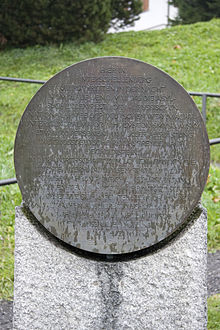1st Russian National Army
|
1st Russian National Army |
|
|---|---|
 Badge of the 1st Russian National Army |
|
| active | April 4, 1945 to mid-April 1945 |
| Country |
|
| Armed forces | Wehrmacht |
| Armed forces | army |
| Strength | 6,000 to 10,000 |
| commander | |
| commander | Boris Smyslowsky |
The name 1. Russian National Army ( Russian 1 ая . Русская национальная армия ) was created on April 4, 1945 and was the last name of a collaborating unit in the service of the German Wehrmacht .
history
In July 1941 the Wehrmacht formed a reconnaissance unit under the leadership of Sonderführer (K) Boris Smyslowsky , a Russian nobleman and former Tsarist guard officer, who initially used the pseudonym Captain von Regenau . The original name of the unit was учебный русский батальон ("Russian training battalion"), the first voluntary Russian formation of the Wehrmacht.
In 1942, the trained unit that operated in the rear of the retreating Red Army to investigate and combat partisans in the occupied territories of the Soviet Union was also known as the Special Staff R (R = Russia). By the end of the war, 12 education schools for agent activity had been set up under the leadership of Boris Smyslowsky.
In 1943 the number of trained collaborating agents amounted to several 10,000, made up of emigrants , prisoners of war and defectors of the Red Army from Central and Eastern Europe. This year again, a new name was used: Special Division R . She tried information about the partisan movement to
- Organizational structure, tactics and weapons to procure and
- the main leaders of the movement, their names and biographies,
- identify their key locations.
In 1945 it was renamed the 1st Russian National Army for the last time , and Army Holmston for camouflage reasons , named after a Swedish uncle of Smyslowski's, Arthuro Holmston. According to one source, an independent project of a Russian military historical society , the First Russian National Army was previously called the Green Army for Special Use . The task continued to be the fight against partisan and underground movements in the areas of Poland and Eastern Europe occupied by Germany. The association consisted of between 6,000 and 10,000 men and had the status of an allied army.
In mid-April 1945 the National Army began to move west after it became clear that the war was lost for Nazi Germany . To avoid capture by Allied troops, which would almost certainly have meant extradition to the Soviet Union, Boris Smyslowsky planned to break away. He and other members of the unit managed to flee to Liechtenstein . On the night of May 3, 1945, the remaining 462 officers and their men crossed the border with the Principality of Liechtenstein near Fresch , a district of Nofels am Schellenberg . Franz Josef II , Prince von und zu Liechtenstein , and the country's government ignored a Soviet extradition request and granted asylum until the emigration of many refugees to Argentina was arranged. While some stayed in Liechtenstein, the remaining soldiers decided to return to the Soviet Union . In 1980 the Russians Memorial was erected in memory in the Liechtenstein community of Schellenberg .
The number of victims due to the actions of these secretly operating Smyslovski's forces is not known, neither those among the civilian population or among the partisan units, nor those of their own unit.
literature
- Henning Freiherr von Vogelsang: To Liechtenstein - to freedom. The adventurous path of the “1. Russian National Army in the German Wehrmacht ”to asylum in the Principality of Liechtenstein. Schellenberg community 1980.
- Henning Freiherr von Vogelsang: End of the war in Liechtenstein. The fate of the First Russian National Army in the German Wehrmacht . Freiburg im Breisgau 1985.
- Henning von Vogelsang: The army that was not allowed to exist. Russians in German uniforms and their rescue in Liechtenstein . Gerhard Hess Verlag, Ulm 1995, ISBN 3-87336213-9 .
- Peter Geiger, Manfred Schlapp: Russians in Liechtenstein. Escape and internment of Holmston's Wehrmacht Army 1945–1948 . Vaduz, Zurich 1996. (with a list of internees and Georgi Simon's Russian diary)
- Nikolai Tolstoy : The betrayed of Yalta . Ullstein, Frankfurt a. M. 1987, ISBN 3-548-33079-7 (Ullstein Taschenbuch 33079).
Individual evidence
- ↑ 1. Rosyjska Armia Narodowa , publications of the Polish encyclopedia Naukowy.pl (Polish)
- ↑ Яков Черкасский Борис Смысловский: нацист, он же русский патриот? , in: Русская Германия, May 18, 2012.
- ^ 1st Russian National Army , publications of the Russian military historical society ( Memento from June 15, 2013 in the Internet Archive ) (English / Russian)
- ↑ 1. Rosyjska Armia Narodowa , publications of the Polish Science Encyclopedia (Naukowa.pl), ibid.
